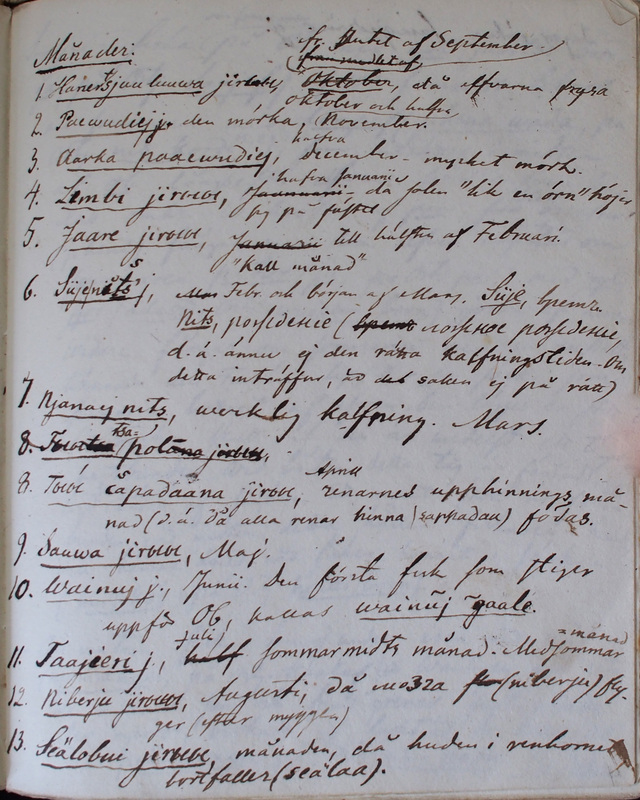Ethnographiska, historiska och statistiska anmärkningar. 250
Title
Ethnographiska, historiska och statistiska anmärkningar. 250
Description
|
Månader:
Several sources mention the Tundra Nenets names for the months. As noted by Golovnev, the Nenets months are not equal in length, but they rather relate to the sun on the one hand and events in nature and among the reindeer on the other. Additionally, there is considerable variation in the names of the months and their order, both regionally and in time. Golovnev ends up describing both the Tundra and Forest Nenets names for the months quite extensively. (Islavin 1847: 139–140; Schrenk 1848: 480–481; Golovnev 1995: 305–329)
1. Hanertsjuuluuwa jiirыы,
Oktober, ifrån slutet af September, då elfvarna frysaTN ханерцeлова иры ʻthe month of the beginning of freezing’ (TaS, KL)
2. Paewudiej j,
den mörka, Oktober och halfva NovemberTN пэвдей ʻdarkness’. According to Tereščenko, нюдя пэвдей ʻsmall darkness’, roughly corresponds to November. (Tereščenko 2003: 501; Golovnev 1995: 319–321) (TaS, KL)
3. Aarka paaewudiej,
halfva December - mycket mörk.TN арка пэвдей ʻgreat darkness’. According to Tereščenko, ңарка пэвдей, ʻbig darkness’ roughly corresponds to December. (Tereščenko 2003: 501; also Golovnev 1995: 319–321) (TaS, KL)
4. Limbi jirыы,
halfva Januarii - då solen "lik en örn" höjer sig på fältetAccording to Tereščenko (2003: 191), лимбя’ ирий, ʻeagles’ month’, roughly corresponds to January. See also лимби иры, ʻeagles’ month’, in Golovnev 1995: 324–325. (TaS, KL)
5. Jaare jirыы,
Januarii till hälften af Februari. "kall månad"TN яра иры ʻthe month during which the sun turns from the thaw’, roughly corresponds to February. (Tereščenko 2003: 780; Golovnev 1995: 323–324) (TaS, KL)
6. Siije|n[-]ts' s
Febr. och början af Mars. Siije, вретъ. Nits, рожденiе (вретъ ложное рожденiе, d.ä. ännu ej den rätta kalfningstiden. Om detta inträffas, är saken ej på rätt) TN сие ниць (иры) ʻfalse calving’, roughly corresponds to April. (Golovnev 1995: 305–308; Tereščenko 2003: 147) (TaS, KL)
7. Njanaej nits,
werklig kalfning. Mars.According to Tereščenko (2003: 147), ты” ниць ирий ʻthe month of proper calving’, roughly corresponds to May. See also ненэй’ ниць ʻproper calving’, in Golovnev 1995: 305–308. (TaS, KL)
8. Tыыtsa=pola̅na jirыы 8. Tыы́ sаpаdaana jirыы,
Aprill, renarnes upphinningsmånad (d.ä. då alla renar hinna sappadaa) födas. TN тыʹ сападана иры ʻbirth of reindeer month’. According to Tereščenko (2003: 678), ты’ саполана ирий ʻthe month of an early birth of reindeer’ roughly corresponds to March and ты” сапо”лана ирий ʻthe month of the birth of reindeer’ roughly corresponds to April. (TaS, KL)
9. Sauwa jirыы,
Maj.According to Tereščenko (2003: 147), саву’ ирий ʻthe month of the flooding of the rivers’ roughly corresponds to June. See also савоʹ иры ʻflood month’ in Golovnev 1995: 307. (TaS KL)
10. Wainuj j[irыы].,
Junii. Den första fisk som stiger uppför Ob kallas wainũj~gaale.TN вэнуй иры. TN вэнуй ʻseason of the mass migration of fish’. According to Lehtisalo венуй иры ʻMonat im Frühsommerʻ (Lehtisalo 1956: 64) (RL, TaS, KL)
11. Taajieri j[irыы].,
Juli, half sommarmidts månad. Midsommar-månad.TN та’ еры иры ʻthe month of the middle of the summer’. According to Tereščenko (2003: 631), таңы ирий ʻsummer month’ roughly corresponds to July. See also таʹ еры иры in Golovnev 1995: 311–312. (TaS, KL)
12. Niberju jirыы,
Augusti, då мозга (niberju) flyger (efter myggen)ниберё” иры ʻmidges’ month’ roughly corresponds to July (Tereščenko 2003: 309; Golovnev 1995: 313). (TaS, KL)
13. Seälobui jirыы,
månaden, då huden i renhornet bortfaller (seälaa)According to Tereščenko (2003: 147), сельбя’ няңы ирий ʻthe month of the shedding of the fur from the horns’ roughly corresponds to September. See also селбуй иры in Golovnev 1995: 312–313. (TaS, KL)
|
Months: 1. Hanertsjuuluuwa jiirыы, from the end of September, when the streams freeze. 2. Paewudiej j, the dark, October and mid-November. 3. Aarka paaewudiej, mid-December – very dark. 4. Limbi jirыы, mid-January – when the sun rises over the terrain “like an eagle”. 5. Jaare jirыы, January until mid-February – “cold month”. 6. Siije nits', February and the beginning of March. Siije 'to lie'. Nits 'birth' (false calving, i.e. not yet the correct calving time. If this happens, it is not right). 7. Njanaej nits, actual calving, March. 8. Tыtsa = pola̅na jirыы. 8. Tыы́ sаpаdaana jirыы, April, the calving month of reindeer (i.e. when all reindeer have time to sappadaa 'to be born'). 9. Sauwa jirыы, May. 10. Wainuj jirыы, June. The first fish to ascend the Ob are called wainũj ~ gaale. 11. Taajieri jirыы, July, half-summer mid-month. Midsummer month. 12. Niberju jirыы, August, when black flies (niberju) flies (after mosquitoes). 13. Seälobui jirыы, the month when the skin of the reindeer antlers is shed (seälaa). |
[[the page is upside down]]

